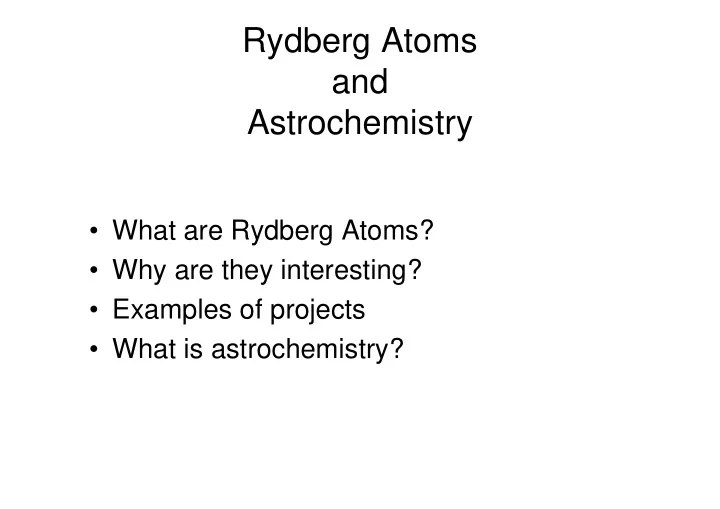

Rydberg Atoms and Astrochemistry • What are Rydberg Atoms? • Why are they interesting? • Why are they interesting? • Examples of projects • What is astrochemistry?
Rydberg atom- one in a state of high principal quantum number n 3 The Rydberg levels are here 2 Energy − R = W n 2 Very weakly bound n=1
Rydberg Atom An atom in a state of high principal quantum number n W= -R/n 2 <r>=2n 2 Large, weakly bound orbits Large, weakly bound orbits V=-1/r n=30 W=-14 meV <r>= 450 Ǻ
Properties of Rydberg Atoms Property scaling n=20 value Binding energy -1/n 2 -274 cm -1 Energy Spacing 1/n 3 27.3 cm -1 Orbital radius n 2 400 Å Dipole matrix elements ( ∆ n=0) n 2 400 ea 0 Geometric cross section Geometric cross section n 4 n 4 160,000 Å 2 160,000 Å 2 Radiative lifetime (low ℓ ) n 3 10 � s Radiative lifetime ( ℓ =n) n 5 1 ms Stark avoided crossings 1/n 4 1 cm -1 10 8 Å 3 Polarizability n 7 Van der Waals interaction n 11
What is interesting about Rydberg Atoms? They have exaggerated properties and interact strongly with the environment. Display physics with clarity 300K black body radiation affecting clocks 300K black body radiation affecting clocks high intensity multiphoton processes Realization of otherwise impossible physical situations counting microwave photons in a cavity- Haroche gates for a quantum computer- Lukin, Grangier et al… time resolved collisions-Renn
Fluorescence detection of excited atoms and molecules Laser excitation Detect fluorescent photon
Detection by field Ionization V=-1/r-Ez W=-1/2n 2 W E=1/16n 4 =2000 V/cm @ n=20
Atoms in Strong Radiation Fields The interaction between an atom and the radiation field Is given by = − µ H E int Either the field can be strong (big laser) or the dipole Either the field can be strong (big laser) or the dipole can be big (Rydberg atom).
Photoionization Fermi’s Golden Rule for the rates 2 Γ = π µ i E f 2 1 2 µ µ i E E f int int Γ = π ∝ E 4 2 ∆ 2 W
Experiment Laser mw Field pulse time Detect atoms surviving the microwave pulse as the laser wavelength is scanned
Atomic beam apparatus/ field ionization detection Lower densities, 10 10 cm -3 high detection sensitivity Kleppner et al
Atomic beam apparatus
Experiment Laser mw Field pulse time Detect atoms surviving the microwave pulse as the laser wavelength is scanned
Experiment with timing change Laser mw Field pulse time Detect atoms surviving the microwave pulse as the laser wavelength is scanned
Obvious structure separated by the photon energy. It takes the same field for ten photon ionization as one photon ionization.
The spectrum is continuous across the limit Microwaves take energy from the electron before it leaves the atom The eigenstates in the presence of the field are combined atom-microwave field states. Fermi’s Golden Rule does not work. Fermi’s Golden Rule does not work.
Interactions of Cold 300 � K Rydberg atoms with each other The major interaction is the dipole-dipole interaction � � � µ • µ − µ • µ • r r 3 ( )( ) = H dd 1 2 1 2 r r 3 r
Dipole Blockade-Lukin States with permanent moments in a static field RR Realization Walker & Saffman Grangier, Brouways Grangier, Brouways & Pillet gR+Rg W gg R
Magneto Optical Trap • 85 Rb • T ~ 300 µ K • d ~ 1 mm • d ~ 1 mm • N ~ 10 10 cm -3 • N T ~ 10 7 atoms
Atoms in a MOT N=10 9 cm -3 R av = 10 -3 cm T=300 � K v=20 cm/s 10 -3 cm n=30 diameter 10 -5 cm 1% of R av On experimental time scale,1 � s, motion 2x10 -5 cm The atoms are effectively frozen in place, like a solid. Dipole-dipole interaction � 2 /R 3 =6 MHz. kT=20 MHz Many body interactions should be more important than binary interactions.
Observe the broadening of the ns-np microwave transition as a function of density np ns npns nsnp
Sweep the frequency of the microwaves through the ns-np transition and record the np signal
Microwave scan from 42s to 42p as function of 42s density 0.30 3 0.313X10 3 12.397X10 0.28 3 26.332X10 0.26 0.24 0.22 42p 1/2 [a. u.] 0.20 0.18 0.16 0.14 0.12 0.10 52388 52388 52388 52390 52390 52390 52392 52392 52392 52394 52394 52394 52396 52396 52396 52398 52398 52398 52400 52400 52400 frequency [X4 MHz]
Excitation and Timing ns nd field ramp laser 480 nm 5p 0 1 2 t ( � s) Plasma n 780 nm 5s
Spontaneous Evolution to a Plasma Rb 40d 2, 5, 12 � s delays 2x 10 5 atoms Radiative lifetime 50 � s
Spontaneous Evolution to Plasma 1. Initial ionization 1. Initial ionization 2. Electrons trapped 2. Electrons trapped 3. Rapid ionization 4. Plasma
Dipole-Dipole Ionization 1/R 3 1/R 6 At R vdW the dipole-dipole interaction equals the detuning. For R <R vdW the good states are (dd±pf)/2 1/2 . R vdW is comparable to the atomic spacing in the trap. Optical excitation is to the dd part (mostly attractive).
•Scanned microwave transition from 39s to 39p 3/2 •Gated the free ion signal •Sharp cutoff at resonance frequency frequency •Cutoff due to exciting pairs on the repulsive (high frequency) interaction curve
What is astrochemistry? Over 140 molecular species have been observed in space, By their microwave rotational transitions. New radio telescopes will add enormous amounts of data. Laboratory measurements are required for identification. High frequency broadband spectrometer Brooks Pate, Kevin Lehmann, John Yates
Present students &post doctoral fellow Joshua Gurian Jirakan Nunkaew Hyunwook Park Richard Overstreet Richard Overstreet
Recommend
More recommend